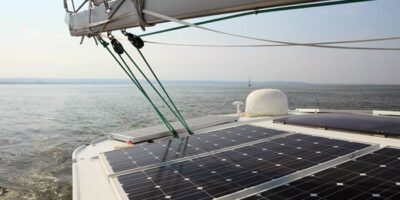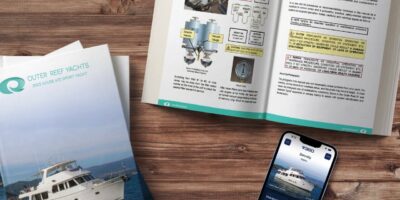The Power Of Checklists
Our memories may be fallible — checklists are not. Learn how to use the power of checklists to your advantage.
- January 16, 2024
We’ve all been there. We leave the boat, then halfway home wonder if we remembered to close the seacocks or connect shore power or some other potentially worrisome chore. We either turn around and go all the way back to check, or have a few sleepless nights until we return to the boat. But there’s a simple, old-school way to avoid this: checklists. You almost certainly already use them anyway (even a recipe is a kind of checklist), so why not use one of the most powerful tools you already have? You’ll not only sleep better, you might even save your boat.
Why You Should Use Checklists
☑ Checklists verify that you’ve done what you need to.
☑ They save time when you have repetitive tasks.
☑ Checklists free up mental memory for other things.
☑ They provide concrete evidence that you didn’t forget anything.
When you do something that involves multiple steps, it’s easy to forget one or two of them, and sometimes missing even a simple thing can have major implications. Checklists counteract our forgetfulness. Many professionals, such as airline pilots, use checklists several times each flight. Airline pilot Brian Koda, who also flies military aircraft as a Naval Reservist, says there are no fewer than six checklists that pilots use just to get the airplane from the gate to the runway. Some checklists, he said, are “written in blood,” which means they were developed after a catastrophe to prevent it from happening again. Surgeons also use checklists to make sure they don’t forget something critical in the operating room. Checklists for boaters can include mundane predeparture routines to those that help you in an emergency, such as what to do if your boat is sinking.
To make them more useful, checklists should be more than just a few things jotted on a scrap of paper. You’ll want to first focus on the essential stuff that is frequently overlooked or skipped that may potentially sink your boat or endanger your crew. Next, what can damage your engine or electrical system? Finally, include a couple of small things that tend to slip through the cracks (see samples below). Checklists should ideally have no more than 10 items and should be able to accomplish in 1 to 2 minutes or they may start to feel like a distraction, which is when people often start “shortcutting,” thus reducing their effectiveness. As the pilot told us, you can’t spell out every single detail; a checklist cannot fly a plane. If you need more items, just make a separate checklist. For example, if your “leaving the boat” checklist is too long, make one for “locking up the boat” and another for “returning to the dock.”
Tip: To make a reusable checklist, laminate the page and use a dry-erase marker to check off each task when completed.
You’ll want to use your checklist, test it, and refine it a few times as needed. If something changes on your boat, like you add a washdown pump that you want to remember to switch off at the panel, add it, though you may need to combine it with other similar tasks so the list doesn’t get too long. In this case, you can add turning off the washdown pump to, say, turn off the cabin lights. For most uses, checklists should be a simple, one-page document printed in an easy-to-read font and a place to clearly check off each item.
Digital Checklists
If you prefer not to use a physical checklist, there are websites and apps that can make the job easy. Google Tasks might be the easiest as it integrates with your Google account if you have one so you can access your checklists on any connected device. Vessel Vanguard also has a checklist integration that is a main feature many people on the app use. To learn more about the checklist feature on Vessel Vanguard, visit our homepage.
There are many apps for making checklists on your smartphone or tablet, and most are free. Many of them sync to all your devices, allowing you to use any connected device onboard.
☑ Remember The Milk
☑ Todoist
☑ Evernote
☑ Microsoft To Do
☑ Wunderlist
☑ Memorigi
For iPhone users, the built-in Notes app also has the ability to easily make checklists, and your iCloud account can make them instantly available on your tablet.
Some checklists will simply be a read-do, which means you read what it says and do it (turn off air conditioner – check; close head seacock – check) while other are do-confirm, which means do the tasks and then pause to verify that everything was done by turning to your checklist and confirming (load boat with supplies and water toys for the day – check).
You can have several checklists for different situations. For example, one for a daily outing, another for returning to the dock, another for leaving the boat for the day, another for winterizing. You may also want to have emergency checklists (boat is taking on water or smoke alarm is sounding). If you’re injured or highly stressed, having a checklist can help you think clearly. And, if they are easy to access, emergency checklists can allow inexperienced crewmembers to help if the skipper is unable.
Sample Checklists
Trailering
☐ Connect coupler to ball — check that latch is locked & bolted securely
☐ Connect safety chains and cross below ball
☐ Connect wiring for lights
☐ Connect safety cable to vehicle
☐ Crank up tongue jack and lock it up
☐ Check winch is tight and locked
☐ Check tire pressure and condition
☐ Check all trailer lights
☐ Check tie-down straps
Gasoline Fueling
☐ Shut off engine
☐ Turn off electronics
☐ Microsoft To Do
☐ Remove all passengers from boat
☐ Close ports, hatches, doors
☐ Make sure it is the proper type of fuel
☐ Open ports, hatches, doors to ventilate
☐ Turn blower on for 4 minutes minimum
☐ Do sniff test
☐ Start engine
☐ Reboard passengers
Starting Engine
☐ Open seacock if inboard or sterndrive
☐ Visually inspect engine and bilge for leaks, loose items, etc.
☐ Inboards and sterndrives: Close engine/ bilge hatch, run blower for 5 minutes prior to starting
☐ Lower outboard engine or sterndrive
☐ Two-stroke owners check oil in tank
☐ Verify safety lanyard in proper position
☐ Check that shifter is in neutral and throttle in correct position
☐ Start engine
☐ Check for oil pressure, cooling water exit
Trailer Boat (end-of-day checklist)
☐ Flush engine per owner’s manual instructions
☐ Remove electronics if not inside cabin
☐ Microsoft To Do
☐ Remove personal items, food, and gear
☐ Stow any gear remaining on boat
☐ Wash down boat, motor, and trailer with biodegradable boat soap and freshwater
☐ Allow to air dry before covering boat
☐ Treat vinyl with dressing
☐ Store under cover — be sure air circulates underneath
Additional Checklists
Charles Fort
Contributing Editor, BoatUS Magazine
About Vessel Vanguard
Vessel Vanguard is a leading marine safety and maintenance management software provider dedicated to revolutionizing the maritime industry. With a commitment to innovation and excellence, Vessel Vanguard delivers cutting-edge solutions to streamline operations and enhance vessel performance and safety.
Latest Industry Insights

Embracing E-Boating Efficiencies

Boat Fuel Systems

The Future of Boats & Boating

Yacht Navigation Light Inspection
View All of Our Industry Insights
Navigate maritime with the latest news, practical how-to guides, insightful analyses and more.
